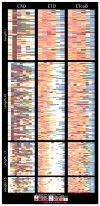Supplemental activation method for high-efficiency electron-transfer dissociation of doubly protonated peptide precursors
- PMID: 17222010
- PMCID: PMC2522365
- DOI: 10.1021/ac061457f
Supplemental activation method for high-efficiency electron-transfer dissociation of doubly protonated peptide precursors
Abstract
Electron-transfer dissociation (ETD) delivers the unique attributes of electron capture dissociation to mass spectrometers that utilize radio frequency trapping-type devices (e.g., quadrupole ion traps). The method has generated significant interest because of its compatibility with chromatography and its ability to: (1) preserve traditionally labile post-translational modifications (PTMs) and (2) randomly cleave the backbone bonds of highly charged peptide and protein precursor ions. ETD, however, has shown limited applicability to doubly protonated peptide precursors, [M + 2H]2+, the charge and type of peptide most frequently encountered in "bottom-up" proteomics. Here we describe a supplemental collisional activation (CAD) method that targets the nondissociated (intact) electron-transfer (ET) product species ([M + 2H]+*) to improve ETD efficiency for doubly protonated peptides (ETcaD). A systematic study of supplementary activation conditions revealed that low-energy CAD of the ET product population leads to the near-exclusive generation of c- and z-type fragment ions with relatively high efficiency (77 +/- 8%). Compared to those formed directly via ETD, the fragment ions were found to comprise increased relative amounts of the odd-electron c-type ions (c+*) and the even-electron z-type ions (z+). A large-scale analysis of 755 doubly charged tryptic peptides was conducted to compare the method (ETcaD) to ion trap CAD and ETD. ETcaD produced a median sequence coverage of 89%-a significant improvement over ETD (63%) and ion trap CAD (77%).
Figures








References
Publication types
MeSH terms
Substances
Grants and funding
LinkOut - more resources
Full Text Sources
Other Literature Sources
Miscellaneous

